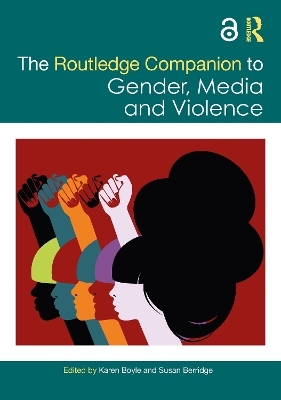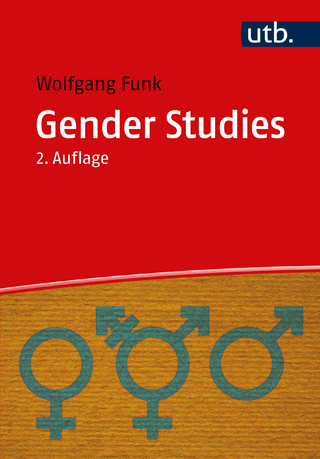
The Routledge Companion to Gender, Media and Violence
Routledge (Verlag)
978-1-032-06136-8 (ISBN)
With the heated discussion around #MeToo, journalistic reporting on domestic abuse, and the popularity of true crime documentaries, gendered media discourse around violence and harassment has never been more prominent.
The Routledge Companion to Gender, Media and Violence is an outstanding reference source to the key topics, problems and debates in this important subject and is the first collection on media and violence to take a gendered, intersectional approach. Comprising over 50 chapters by a team of interdisciplinary and international contributors, the book is structured around the following parts:
News
Representing reality
Gender-based violence online
Feminist responses
The media examples examined range from Australia to Zimbabwe and span print and online news, documentary film and television, podcasts, pornography, memoir, comedy, memes, influencer videos, and digital feminist protest. Types of violence considered include domestic abuse, "honour"-based violence, sexual violence and harassment, female genital mutilation/cutting, child sexual abuse, transphobic violence, and the aftermath of conflict. Good practice is considered in relation to both responsible news reporting and pedagogy.
The Routledge Companion to Gender, Media and Violence is essential reading for students and researchers in Gender Studies, Media Studies, Sociology, and Criminology.
Chapter 30 of this book is freely available as a downloadable Open Access PDF at http://www.taylorfrancis.com under a Creative Commons Attribution-Non-Commercial (CC-BY-NC) 4.0 license.
Karen Boyle is Professor of Feminist Media Studies at the University of Strathclyde, Scotland. Susan Berridge is Senior Lecturer in Film and Media at the University of Stirling, Scotland.
Introduction Part 1: News Introduction 1 "Sensational spikes" and "isolated incidents": examining the misrepresentation of domestic abuse by the media using the case studies of football and Covid-19 2 The media and male victim-survivors of domestic abuse 3 Invisible feelings, Anti-Asian violences and abolition feminisms 4 Towards a fair justice system in Canada: women and girls homicide database project 5 Familicide, gender and "mental illness": beyond false dualisms 6 Femminicidio in Italian televised news: a case study of La Vita in Diretta 7 Cruel benevolence: vulnerable menaces, menacing vulnerabilities and the white male vigilante trope 8 Exploring US news media portrayals of girls’ violence in the 1980s and 1990s: the emergence of a moral panic 9 Child sexual exploitation and scapegoating minority communities 10 Hidden or hypervisible? Mapping the making of a moral panic over female genital mutilation/cutting 11 Examining the Zimbabwean news media’s framing of men as victims of sexual assault 12 The HIV man, Alexandra man and Hotboy: Swedish news coverage of rape as a folklore of fear 13 Forward and backwards: sexual violence in Portuguese news media 14 Representations of gender-based violence against children in Nigeria 15 Media, courts and "#RiceBunny" testimonies in China 16 Journalism, sexual violence and social responsibility Part 2: Representing Reality Introduction 17 The politics of the traumatised voice: communicative injustice and structural silencing in contemporary media culture 18 Public survivors: the burdens and possibilities of speaking as a survivor 19 Telling an authentic, relatable #MeToo story on YouTube 20 Mental images and emotive voices in true crime podcasts focused on female victims 21 Sexual violence and social justice: the celebrity #MeToo documentary in the US 22 Remediating the "Yorkshire Ripper" event in the era of feminist true crime 23 Class, victim credibility and the Pygmalion problem in real crime dramas Three Girls and Unbelievable 24 Victimhood and violence: weaponising white femininity in South Africa 25 Pregnant and disappeared: the Missing White Woman Syndrome in magazines 26 Discourses and narratives of gender-based violence in Greek women’s magazines 27 Just a fantasy: how the discourse of fantasy attempts to resolve the conflicts of porn consumption 28 Patriarchal protectors of the national body: violence, masculinity and gendered constructions of the US/Mexico border 29 Militarised masculinity and the perpetration of violence in Chilean documentary 30 Women’s activist filmmaking against gendered violence in Pakistan Part 3: Gender-based violence online Introduction 31 Technology-facilitated abuse: intimate partner violence in digital society 32 Tactics of hate: toxic "creativity" in anti-feminist men’s rights politics 33 Bad actors or bad architecture: rethinking gendered violence online 34 Networked misogyny on TikTok: a critical conjuncture 35 Naming and framing the harms of cyberflashing: men sending non-consensual dick pics 36 The non-consensual dissemination of intimate images on Telegram: the Italian case 37 Online child sexual exploitation in the news: competing claims of gendered and sexual harm 38 Responding to transphobic violence online 39 Homophobic humour in rape memes 40 Online discourses of violence against men: portrayals of neglect, discrimination and equality gone too far 41 The curious case of Karen Carney: the argument for equity over equality in curbing the online abuse of women in sports media 42 "Online othering": the case of women in politics 43 Cyberviolence against women in politics 44 Violence and the feminist potential of content moderation Part 4: Feminist Responses Introduction 45 Engaging men online: using online media for violence prevention with men and boys 46 Hashtag feminism in Brazil: making sense of gender-based violence with #PrimeiroAssédio 47 After the affect: the tenuous leadership of viral feminists 48 Mediatisation of women’s rage in Spain: strategies of discursive transformation in digital spaces 49 Francesca Belotti, Vittoria Bernardini and Francesca Comunello Hashtag feminism straddling the Americas: a comparison between #NiUnaMenos and #MeToo 50 Kaitlynn Mendes and Euisol Jeong Digital feminist activism against gender violence in South Korea 51 Munira Cheema Women 2020: how Pakistani feminisms unfolded between Twitter and the streets 52 Digital feminist and queer activism against gender violence in China 53 Controversies, protests, coalitions: screen media’s lessons from the past 54 Collective action, performance and the body-territory in Latin American feminisms 55 Doing feminist activism though creative practice research 56 Rethinking the curriculum: #MeToo and contemporary literary studies 57 I won’t look: refusing to engage with gender-based violence in women-led screen media
| Erscheinungsdatum | 30.08.2023 |
|---|---|
| Reihe/Serie | Routledge Companions to Gender |
| Zusatzinfo | 2 Tables, black and white; 3 Line drawings, black and white; 3 Halftones, black and white; 6 Illustrations, black and white |
| Verlagsort | London |
| Sprache | englisch |
| Maße | 174 x 246 mm |
| Gewicht | 1370 g |
| Themenwelt | Geisteswissenschaften ► Geschichte |
| Sozialwissenschaften ► Soziologie ► Gender Studies | |
| ISBN-10 | 1-032-06136-7 / 1032061367 |
| ISBN-13 | 978-1-032-06136-8 / 9781032061368 |
| Zustand | Neuware |
| Informationen gemäß Produktsicherheitsverordnung (GPSR) | |
| Haben Sie eine Frage zum Produkt? |
aus dem Bereich


